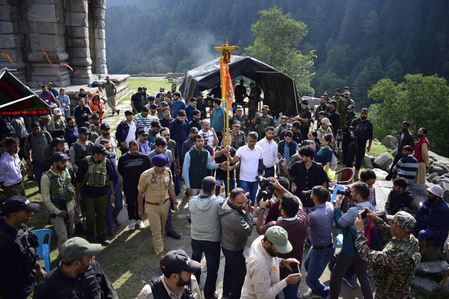
Srinagar, Aug 30 (IANS) The 17th annual Gangbal Yatra started on Saturday with a traditional flag-off ceremony at Naranag in Jammu and Kashmir’s Ganderbal district, officials said.
The yatra takes Kashmiri Pandit devotees to the sacred Harmukh Gangbal Lake, located at an altitude of 14,500 feet in the Harmukh mountain range.
Revived in 2009 after remaining dormant for more than 150 years, the pilgrimage is organised every year by the Harmukh Ganga Gangbal Trust (HGGT).
This year’s journey commenced with the Charri Pooja at Naranag, attended by Kashmir Divisional Commissioner Anshul Garg, Ganderbal Deputy Commissioner Jatin Kishore, Ganderbal Senior Superintendent of Police Ragav S, Kangan Sub-Divisional Magistrate Nazir Ahmad and senior officers from the Army and CRPF.
Addressing the gathering, Divisional Commissioner Garg praised the local Kashmiri Pandit community for its continued support in sustaining the annual pilgrimage.
He also lauded the role of the district police, Army, and paramilitary forces for facilitating safe and smooth arrangements.
The organisers, with the assistance of the administration and security agencies, have made elaborate arrangements for the pilgrims.
Facilities include free langar services at multiple points, pony assistance, sleeping bags, registration cards, and the presence of priests at the Gangbal Lake to conduct rituals.
The trust’s core team comprising Vinod Pandit, Vinay Kaul, Pradeep Pandita, Vinod Tikoo, and others expressed gratitude to the administration, security forces, and residents of Naranag for their cooperation.
This year marks the 17th uninterrupted edition of the yatra since its revival.
Gangabal Lake on the foot of the Harmukh mountain peak is sacred to the Kashmiri Pandit community.
Historically, the local Pandits would carry the ashes of their dead for immersion to the Gangabal Lake to seek purification of the dead.
Folklore has that Lord Shiva and Mata Parvati had their abode at the Harmukh Peak from where the divine couple went to the Amarnath cave where Lord Shiva narrated the secret of eternal life to Mata Parvati.
The secret was heard by a pair of pigeons in the Amarnath Cave and folklore has that the pair of pigeons also became immortal after hearing the divine secret of eternal life.
The 12th century scholar and historian, Kalhana Pandit wrote the epic ‘Rajatarangini’ at Naranag temple. It is the 5000-year historical record of Kashmir.
The Naranag temple is the main attraction for tourists now.
It is one of the important archaeological sites of the country.
The site consists of a cluster of temples facing each other at a distance of about 200 metres.
Historians say that the temple is dedicated to Lord Shiva and was built by Lalitaditya Muktapida, of the Kayastha Naga Karkota dynasty in the 8th century A.D.
It is believed that the king Awantivarman paid a visit and donated a pedestal for bathing at Bhuteshwar.
The Naranag Temple has a spring near the temple.
The temple is believed to be dedicated to the ancient Nagas. Hence, the name “Naranag”.
It was built by the Naga Karkotas, who are said to be Hindu Kashmiri Saraswat Brahmins of the Naga sect, known for their reverence for serpents.
They used to stay here and do their sadhanas.
According to local belief, these structures are built by some supernatural powers called (‘daya’) in the local language.
Such beliefs remain popular among residents.
The government has built perimeter walls around the temple ruins to protect it from encroachment.
Every year on the eve of pilgrimage to Gangabal Lake by Kashmiri Pandits, prayers are offered at the temple complex to begin the pilgrimage.
–IANS
sq/khz
